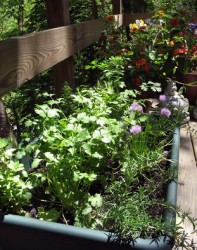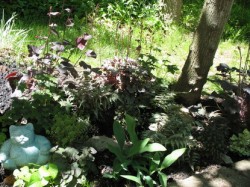How Does My Garden Grow?
It is difficult to watch the rain pour down in a cool, wet spring, and not be out in the garden.
I spent most of last week, waiting for a break in the clouds, a temporary cessation in continual drizzle, then dashing out to dig a few holes, and plant a few new starts, or pull a handful of weeds here and there, deadhead some annuals, and fret over the basil plants.
I despair for my lovely planter box of basil; they started out so lush and full of promise, and now are going flabby and starting to wither.
It is the cold and wet. This has been one of the coldest, dampest months of May I can remember; our nights have been in the low forties for several weeks now, and the days have not been much warmer than the sixties. While the tomato plants chug along, happily setting forth new leaves and even setting blossoms, the basil pouts, drooping and weary.
I fear that I may have to replace the lot of them; they’re as tired and spent as old washerwomen, shoulders rounded, heads bowed, and waistes spindly.
But the rest of the garden flourishes, and grows into itself. The tomatoes are already setting blossoms up on the deck, the windowboxes and herb planters on the deck railings and floor, grow with abandon, and the potted and plantered annuals give a new show of exuberent color every day.
I cannot help but be pleased at that.
Down in the front of the house, along the retaining wall that defines the right side of our driveway, the mostly shaded garden border is alive with promise. It is a mixture of perennials and herbs that we started last year, and have added considerably to this year. It is patterned off of the colors, textures and shapes seen in the dappled shade of a forest floor; one can tell I grew up wandering the hills and bottomlands of my grandfather’s woodlot, soaking in the partnership between wood, water, plant and stone that makes the forest such a study in artless beauty.
My aesthetic sense was informed by those early experiences, but they were also morphed by my love of fairy and folklore as a young adult. The descriptions of the secret lands of Faerie and Neverland by Yeats and Barrie and the illustrations of Rackham and Froud also inform my garden design, leading me to adore variagated texture, deep colors juxtaposed with silvery foliage and sudden burst of brilliant bloom, and the infatuation with smaller plants, such as violets, primulas and corydalis–many of which have folkloric associations with the cparicious sprites the English common folk called “The Gentry,” or “The Good Folk” as terms of respect and appeasement.
The gardens of the East, particularly, Japan, also have lent their timeless, serene stamp upon my sense landscape aesthetics. The use of natural materials, of plants harmoniously planted to simulate the ways in which they grow in nature, and the use of minature plants to create small landscapes, finds expression in the gardens that Zak and I create. This very naturalistic style is most evident in our shady areas; in the sun, I am wont to let my love of the English cottage garden hold sway, with flowers growing in an enthusiastic jumble of blossoms, all running wild and rampant, in a glorious profusion that gives my spirit great satisfaction and quiet joy. Letting morning-glory vines twine themselves around the stems of sunflowers, then ramble over a hedge of lilacs just makes me smile as the blue trumpet flowers make a halo around the great shaggy yellow sunfaces of their host.
The English cotter’s tendency to mix food plants, culinary herbs, medicinals and decorative plants into a great tangle also has invaded my design sense. Ifyou look closely at my photographs of the shade bed that looks very woodland Japanese, you can see miniature purple basil, several varieties of thyme, sweet woodruff, catmint, and several other varieties of mint, all interspersed with the strictly ornamental plants like the heucheras and Japanese painted ferns. At the end of the month, when we start working on the other side of the driveway area, this one in sunnier locale, there will be even more obvious mixtures of the ornamental and the useful: garden sage, mint, bergamot, echinacea and valarian, all culinary and medicinal herbs, will grow freely among the shasta daisies, rudbeckia, iris, and salvia.
This coming week, we have an appointment with a man who does stonework for gardens. We want him to help us put large stones in to help retain a bit of clay subsoil that is washing out, and to pave an area next to the hot tub (it came with the house) that sits outside our side door. After he has done the heavy work of putting in the drainage and the stones, Zak and I, and our dear gardening helper Dustin (who does the things that I am not allowed to do now that I am pregnant, like dig trenches and shovel great piles of compost and manure, in addition to mowing the crazy slope of our back yard.), will put in pockets of good rich planting soil among the stones and plant ostrich ferns and hostas among the boulders, brightening the corner next to our garage that is perpetually shaded by our deck above. One springtime benefit that the ostrich fern plantings will bring in future years will be crops of fiddleheads in the early spring, just as the bamboo we plan to plant around the hot tub to screen it will offer edible shoots that I can prepare from scratch, instead of using canned.
While we have the master stoneworker here, we will have him look at the expanse of slope in our backyard. This is the best gardening space our property offers–it is a wide semi-circle of beautiful, arable land, all of it, unfortunately, on a forty-five degree slope that is very treacherous to clumsy pregnant-woman feet. (Needless to say, I only gaze upon it from afar now.) It is bounded by mature trees, and bordered on two sides with hedgerow, and it gets hours of full and dappled sun each day. We want this man to take whatever machines he needs to cut terraces from it–we have in our heads to make them irregular and composed half of straight angles and half of graceful curves, in the manner of rice paddies–so that we can then remove most of the lawn from our landscape, and instead garden to our hearts’ content.
What do we want to put in?
I should like a few fruit trees, but would be content with blueberries, strawberries and maybe some raspberries–the blueberries and raspberries along the hedgerow, with climbing roses and native honeysuckles. We must have our own asparagus patch; not only will it give us gustatory pleasure for years to come, but the ferny-airy growth of the plant in the summer can make a lovely backdrop to any number of other plants. Herbs, for certain will be dotting the terraces, tucked in here and there. I cannot resist poking them in wherever they will fit and grow; thyme particularly, will have to be planted to spill over retaining walls and creep along stonework. Roses, too, will be a part of garden, for if there is one thing that both Zak and I miss with a longing that is both sad and deep, it is our roses–beautiful queenly blossoms that brought fragrance and sensuality to our gardens.
And, to our kitchen, for that matter. I will tuck into the landscape as many edible flowers and plants as I can, all the while noting how beautiful they are alongside the strictly ornamental flowers and plants that grace the gardens of people primarily concerned with aesthetics. I am reminded every time I look at a tomato plant, for example, for how many years tomatoes were grown in Europe and America as strictly ornamental plants, grown for the lovely fruits that people admired for their beauty, but refused to eat.
How, then does my garden grow? It grows with love, and care and nurturing, and in return, it nurtures me back. It grows in my dreams, and I believe that its dreams grow into me.

It is hard for me to write this now, in fact, for the sun is shining, and the garden calls me. There are always a few weeds to pull, a bit of mulch or compost to place, or some seeds to plant. I still have my methi seeds to sprout yet, and put into pots. I still need to run out to find some good garden sage and tarragon for my last herb planter, along with some good Greek oregano and another rosemary or two.
I will go now, then, and dash out into the sun, and let the garden whisper her secrets to me, as I strain to listen and catch them all.
9 Comments
RSS feed for comments on this post.
Sorry, the comment form is closed at this time.
Powered by WordPress. Graphics by Zak Kramer.
Design update by Daniel Trout.
Entries and comments feeds.












My grandparents have a very steep slope behind their house – they essentially live on the side of a hill. Over the year, they’ve put in wood terraces and have a stone and brick step path that winds slowly around the side of the house and through the different terraces. That way, they can both safely walk around the back even in the rainy season. It’s certainly doable, and watching their garden grow from the front, around the side, and now down the back has been inspiring.
Comment by Becca — May 21, 2006 #
Hey Barbara, is there nothing you do wrong? You even spell “faerie” in the right way 🙂
Brilliant post – am now off to sow wild flowers in my window boxes 😀
Steph
Comment by Steph — May 21, 2006 #
Wow, what a beautiful garden! I’d love to grow blueberries, especially. It’s autumn here so my herb garden is starting to suffer…this is making me long for spring.
Comment by Stephanie — May 21, 2006 #
Your garden and your future plans for it- all look and sound wonderful, Barbara.
Gardening, however we do, in a big patch of land or in small containers, has this unique, ‘we are doing something worthwhile with our time’ quality and also brings peace and happiness. I love that about gardening. and I loved reading your post. Thanks for sharing.
Comment by Indira — May 21, 2006 #
Becca–I am excited about getting the terracing done so we can really get down to gardening business, as it were! One of the largest issues, in fact, with the terracing is safety–the slope is steep and pretty slippery, and even when I do not have the added issue of loosened pregnancy joints and changed center of gravity, I am wont to come down that hill. Even Zak and Morganna have trouble with it, so I can only imagine how it would be for me in later years.
Your grandparents sound like great gardeners, too. There is always something interesting happening in a garden, and I swear that gardening keeps older people spry and sharp for many, many years. It is very healthy to be outside playing with and puttering around plants. It keeps us young, in body mind and spirit.
Your grandparents sound like they rock!
Steph–there are things I do not do well. Higher mathematics are a mystery to me. It might as well be magick, it is so far over my head. I can still do algebra and geometry (which have applications in my daily life, so of course I can do them), but trig and calculus were and are yet beyond me. And that is fine.
As for spelling Faerie correctly–one must be ever vigilant in the correct useage of names and epithets when it comes to the Good Folk. Hence my care in spelling. 😉 Besides, folklore study has been a fascination of mine since childhood, so it is not surprising I know oddities like how to spell Faerie properly and difference between a selkie and a kelpie. 😉 I hope you have fun with those wildflowers!
Stephanie: autumn is a good time, too. The feeling of the exuberance of summer winding down, the preparation for a good long rest–all of these feelings are good ones.
If you want to grow blueberries, keep in mind they love acidic soil. I know folks who grow them in big planters or boxes filled with with sawdust or peat moss, or a combination of the two, and they get great harvests. That is just something to keep in mind….
Indira–you are right. Gandhi, whom I admire for many reasons, once said, “To forget how to dig the soil and tend the earth is to forget ourselves.” Even if he had never done any other wonderful thing in his life, even if he said nothing else so wise again, I believe I would love him and honor him for that one simple sentence alone.
To forget the soil and the earth is to forget ourselves.
Those are words that I strive to live by.
Comment by Barbara — May 22, 2006 #
I found your blog a few weeks ago and have been steadily devouring it from the end back to the beginning. You’re so genuine about everything you discuss that I can’t help but check in compulsively to see if you’ve updated. (Not to mention I love the stories behind your recipes.)
But this isn’t why I finally decided to post a comment.
I’m a city girl. I was born in a major city and was raised in another one. But I was also raised in a family where fresh grown food was considered a staple. We had a summerhouse which boasted a huge garden thanks to the efforts of my grandparents. Even now that they live in Brooklyn, they have managed to transform the paltry backyard of their building into a small growing space with anything from tomatoes to raspberries.
So maybe it’s in my blood. Or something. I have been contemplating my own garden for years, rather idly. Now I am about to move to Long Island to attend law school and am going to rent a house with a number of housemates. I was pleasantly surprised that one of them has experience in growing her own garden.
And thus we are resolved to buck the suburban trend, ignore the call of the lawn mower and plant our way around whichever house it is that will get rented to our tender mercies. What we cannot grow, we will attempt to get locally when we can.
In some part, this plan has solidified because of your blog. And so I thought it was only fair to admit it.
Comment by Irina — May 23, 2006 #
Welcome, Irina, it is nice to meet you!
Thanks for commenting–it is always good to meet my readers.
I am -very- happy to hear that I have been part of your inspiration to finally go out and start your own garden. Go on, girl, and grow a garden of delights rather than a boring old useless patch of lawn!
If you ever have any questions about gardening–let me know. If I don’t know the answer, or cannot find it, rest assured I know folks I can ask.
Good luck with your garden–and with law school!
Comment by Barbara — May 23, 2006 #
Do you sleep? I love reading your blog.
Comment by Gabriella True — May 26, 2006 #
[…] is the only place that gets enough light for growing such things. I’ve chronicled our success with this approach here on this blog, but this year, I wanted to do something bigger. I yearned to […]
Pingback by Tigers & Strawberries » Persistent Herbicides in Commercial Compost = Stunted Vegetable Garden — June 8, 2011 #